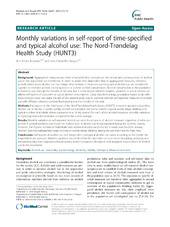| dc.contributor.author | Knudsen, Ann Kristin | en_US |
| dc.contributor.author | Skogen, Jens Christoffer | en_US |
| dc.date.accessioned | 2015-12-28T10:14:44Z | |
| dc.date.available | 2015-12-28T10:14:44Z | |
| dc.date.issued | 2015-02-21 | |
| dc.Published | BMC Public Health 2015, 15:172 | eng |
| dc.identifier.issn | 1471-2458 | |
| dc.identifier.uri | https://hdl.handle.net/1956/10820 | |
| dc.description.abstract | Background Aggregated measures are often employed when prevalence, risk factors and consequences of alcohol use in the population are monitored. In order to avoid time-dependent bias in aggregated measures, reference periods which assess alcohol use over longer time-periods or measures assessing typical alcohol use are considered superior to reference periods assessing recent or current alcohol consumption. Alcohol consumption in the population is found to vary through the months of the year, but it is not known whether monthly variations in actual alcohol use affects self-reports of long-term or typical alcohol consumption. Using data from a large, population-based study with data-collection over two years, the aim of the present study was to examine whether self-reported measures of alcohol use with different reference periods fluctuated across the months of the year. Methods Participants in the third wave of the Nord-Trøndelag Health Survey (HUNT3) answered questions regarding alcohol use in the last 4 weeks, weekly alcohol consumption last twelve months, typical weekly binge drinking and typical number of alcoholic drinks consumed in a 14 day period. For each of the alcohol measures, monthly variations in reporting were estimated and compared to the overall average. Results Monthly variations in self-reported alcohol use were found across all alcohol measures regardless of reference period. A general tendency was found for highest level of alcohol use being reported during the summer season, however, the highest number of individuals who reported alcohol use in the last 4 weeks was found in January. Women reported substantially larger increase in weekly binge drinking during the summer months than men. Conclusions Self-reports of alcohol use over longer time and typical alcohol use varies according to the month the respondents are assessed. Monthly variations should therefore be taken into account when designing, analyzing and interpreting data from population-based studies aimed to examine descriptive and analytical characteristics of alcohol use in the population. | en_US |
| dc.language.iso | eng | eng |
| dc.publisher | BioMed Central | eng |
| dc.rights | Attribution CC BY | eng |
| dc.rights.uri | http://creativecommons.org/licenses/by/4.0 | eng |
| dc.subject | Alcohol use | eng |
| dc.subject | Epidemiology | eng |
| dc.title | Monthly variations in self-report of time-specified and typical alcohol use: The Nord-Trøndelag Health Study (HUNT3) | en_US |
| dc.type | Peer reviewed | |
| dc.type | Journal article | |
| dc.date.updated | 2015-11-05T12:38:50Z | |
| dc.description.version | publishedVersion | en_US |
| dc.rights.holder | Copyright Knudsen and Skogen; licensee BioMed Central. 2015 | |
| dc.identifier.doi | https://doi.org/10.1186/s12889-015-1533-8 | |
| dc.identifier.cristin | 1276294 | |
| dc.subject.nsi | VDP::Medisinske fag: 700::Helsefag: 800::Samfunnsmedisin, sosialmedisin: 801 | |
| dc.subject.nsi | VDP::Midical sciences: 700::Health sciences: 800::Community medicine, social medicine: 801 | |
| dc.subject.nsi | VDP::Medisinske Fag: 700 | en_US |

